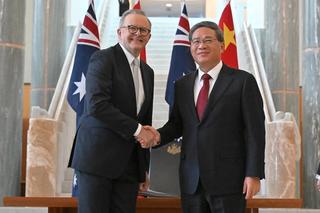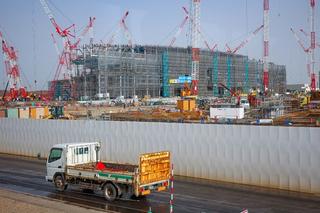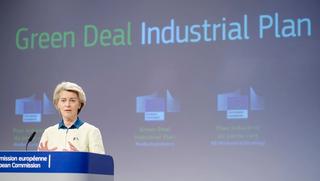International economics is changing. Since the 1990s, advanced economies have focused on expanding links between countries – encouraging more trade and more investment. But shocks such as the Covid-19 pandemic, geopolitical tensions and wars, alongside broader societal trends such as backlash to globalisation and cost of living concerns, have led to cracks in the global system.
Now, governments are beginning to craft new economic security policies – putting up trade and investment barriers, pursuing industrial policy and greater self-sufficiency. Comparing the policies of a group of advanced economies – Australia, the United States, Japan, the European Union (EU), the United Kingdom and South Korea – shows trends and alignment, but also areas of competition and divergence, even among allies and partners.
The unique economic and security concerns, interests and priorities of these individual countries mean they each adopt slightly different policy approaches. Some countries lack natural resources and rely on others to secure supplies of food or energy, some rely more heavily on foreign trade.
Broadly, there are three trends driving economic security policies in advanced economies:
Economic security policies can be categorised as more outward or inward-facing.
- Inward-facing policies: investments in the domestic economy, such as state support for private industry, often in the form of public-private partnerships and with dual motivations – national security and jobs.
- Outward-facing policies: directed at other countries – for example, trade and investment restrictions, free trade agreements (FTAs) or development assistance.
A third factor is growing policy coordination between groups of ‘likeminded’ countries. For example, recent G7 statements increasingly mention supply chain resilience and China’s non-market policies. There are new partnerships dedicated to particular sectors, such as the Minerals Security Partnership, a forum for 14 countries to coordinate investments in critical minerals, or the EU-US Trade and Technology Council.
Table 1: Economic security policies compared
International alignment
There has been increasing alignment between countries on the nature of their economic security concerns, including reducing overdependence on China for critical goods and protecting critical infrastructure. Nearly all the countries and groups assessed have updated their foreign investment screening regimes, implemented sanctions policies and, despite initial backlash to the United States, most are now pursuing some form of industrial policy. This typically relates to semiconductors, critical minerals or clean energy manufacturing, depending on their domestic resources.
Although there is alignment, differences between economic security policies remain. Some countries like Australia, Germany, Japan and South Korea are more heavily economically intertwined with China. Some are more wary of using government funds to support industries. Two current points of contention are trade and export controls. The United States, due to domestic politics and sensitivity to unfair trade practices, has pulled away from participating in free trade agreements, while countries like Australia, Japan and the United Kingdom continue to embrace them. The United States and EU have increased tariffs targeting China with the United States the most liberal user. There is a growing desire to counter industrial overcapacity from China but not all countries are willing to use tools like tariffs that could hurt their domestic population.
Economic security policies often require trade-offs – protecting technologies may hurt domestic industries, diversifying trade could impact prices – and each country has a different appetite for risks.
Further, the United States has pursued a series of export control restrictions targeting advanced semiconductor manufacturing in China. There has been some buy-in from other allies critical to the semiconductor supply chain (Japan and the Netherlands have placed export controls on semiconductor manufacturing equipment, South Korea has not) but none have gone as far as the United States.
Future cooperation on economic security will be essential for reciprocal investment to create stronger supply chains, to avoid inadvertent harms from industrial policy and subsidies, to align export controls to maximise effectiveness and minimise damage, or simply learn from the successes and failures of each other’s policies. But countries must recognise that these policies will also depend on the interests and domestic politics of each country, which will complicate coordination. Economic security policies often require trade-offs – protecting technologies may hurt domestic industries, diversifying trade could impact prices – and each country has a different appetite for risks.
The United States
Much of US economic security policy is about strategic competition with China – limiting China’s technology development and market dominance, addressing China’s theft of US intellectual property (IP) and investing in the United States’ own competitiveness. The United States is much less trade-dependent than many other advanced economies because its large, diversified economy can provide many goods domestically. But it remains reliant on particular global chokepoints in its supply chains. A current concern for the United States (alongside the EU and others) is China’s ‘industrial overcapacity’ whereby government subsidies lead Chinese companies to overproduce, exporting excess production around the world, lowering prices and threatening competing US industries.
For much of the 21st century, the United States’ international economic policies championed free trade, open markets and globalisation. But as the downsides of global economic openness emerged, it sparked backlash among parts of the American public. In 2016, former President Donald Trump ran on an anti-free trade platform, railing against the US trade deficit with China, job losses in manufacturing, and trade agreement violations. During the Trump administration, economic security became a higher priority. The 2017 National Security Strategy added a new pillar – “promote American prosperity” – primarily concerning economic security. When President Biden was elected in 2020, he dialled back Trump’s anti-free trade rhetoric but the overlap between the international economy, national security and domestic policy remained.
1. Inward policy
Industrial policy has become one of the defining features of the Biden administration. In 2021 and 2022, the United States passed three landmark pieces of legislation:
- Infrastructure, Investment and Jobs Act (IIJA): a US$1.2 trillion spending package on US infrastructure – from roads to energy.
- CHIPS and Science Act: US$280 billion for the semiconductor and research industries, including US$39 billion in subsidies to attract investment in domestic manufacturing facilities.
- Inflation Reduction Act (IRA): US$369 billion in loans, grants and tax incentives for the US energy transition, including subsidies for the domestic manufacturing of clean energy technologies.
So far, these policies have increased investment into US manufacturing. Ten new multi-billion semiconductor foundries are under construction. Since the IRA, US$133 billion in private sector investments in clean technology manufacturing have been announced.

2. Outward policy
“By the time President Biden came into office, we had to contend with the reality that a large non-market economy had been integrated into the international economic order in a way that posed considerable challenges.”
Jake Sullivan, National Security Adviser, 2023
Since the 2010s, the United States has gradually reevaluated its trade policy. The Global Financial Crisis, the ‘China Shock’ narrative (that increasing trade with China resulted in large job losses in US manufacturing industries) and accusations of unfair trade practices all contributed to growing discomfort with the traditional global trade architecture.
Upon entering office, Trump immediately pulled out of the Trans-Pacific Partnership, a twelve-country free trade agreement championed by the Obama administration, and obstructed the effectiveness of the World Trade Organization (WTO). The Trump administration placed tariffs on most imports of steel and aluminium, as well as two-thirds of Chinese imports. The Biden administration has kept many of Trump’s policies, with a more strategic and targeted approach. The Biden administration suspended tariffs on EU steel and aluminium and pursued some limited trade agreements such as IPEF, but nearly all of Trump’s China tariffs remain. The Biden administration has gone even further, introducing or increasing tariffs on an array of Chinese products, designed to incentivise domestic manufacturing of goods for which the United States is overly reliant on Chinese imports and protect US industries from China’s growing market share.
A bipartisan domestic trend towards protectionism and a desire to maintain technological dominance means that no matter the outcome of the 2024 election, the US approach to international economics will remain relatively consistent.
On top of tariffs, the United States has used export controls to limit China’s access to US technology. National Security Adviser Jake Sullivan described this approach as, “protecting our foundational technologies with a small yard and high fence” – meaning select technologies would be kept out of China via tighter export control policies. Inside the 'fence' are primarily technologies related to advanced semiconductors, with a suite of export controls announced in 2022. The United States has pushed for other countries to coordinate export controls.
Foreign investment has also become a target. Reforms have increased scrutiny on inbound investment and in 2022 the Biden administration proposed a new outbound investment screening mechanism to curb US investment into select high-tech industries in China.
US economic security policies
The United States’ approach to economic security has taken a far-reaching and more proactive approach than many of its allies and partners. Its use of industrial policy has attracted criticism both domestically and abroad (including from allies like Japan, South Korea and the EU) that worry these policies advantage US industries, at others’ expense. But a bipartisan domestic trend towards protectionism and a desire to maintain technological dominance means that no matter the outcome of the 2024 election, the US approach to international economics will remain relatively consistent.
Australia
Australia’s approach to economic security balances its close trading relationship with China and its growing national security concerns, primarily pursuing inwards-facing policies rather than trade barriers. A series of shocks of the past few years, including Covid-19 supply disruptions, its experience of economic coercion by China and the energy transition have driven its economic security policymaking.
Resource-rich, Australia is dominated by its mining, energy, agricultural and service sectors. Since the 1980s, Australia has embraced open, trade-oriented economic policies. Exports and imports combined make up 45% of Australia’s GDP. Of particular note is its large trading relationship with China that accounted for almost a third of Australian exports and around a fifth of imports in 2022-23. The figure below highlights the increasing importance of exports to Australia’s economic prosperity and China’s dominance within Australia’s trade partnerships.
Figure 1. Australia’s share of trade with top partners, 1990-June 2024
Share of Australia's trade with top trading partners over time
1. Inward policy
“Nations are drawing an explicit link between economic security and national security… this is the new competition.”
Anthony Albanese, 2024
While Australia is mostly self-sufficient in producing energy and food, it relies on imports for many manufactured products. Supply chain disruptions during the Covid-19 pandemic shifted government policy from a ‘just in time’ to a ‘just in case’ supply strategy, making public investments in domestic production of critical products like fertiliser and pharmaceuticals.
Australia has also stepped up its investment in its manufacturing capacity, announcing grants, loans and equity to targeted industries. The largest announcement so far has been the A$22.7 billion Future Made in Australia Act (FMIA), positioned as Australia’s response to the economic security policies of other countries. Australia seeks to capitalise on the increasing overlap between national security concerns and clean energy, a sector currently dominated by China. Australia is geologically rich and home to large deposits of the critical minerals its allies seek. FMIA and many other Australian Government investments focus on the mining and processing of critical minerals as well as other clean energy industries it seeks to play a larger role in, such as hydrogen.
2. Outward policies
“Our constituency’s economic prosperity remains heavily reliant on global free trade flows that are supported by an effective rules-based World Trade Organisation.”
Jim Chalmers, Treasurer of Australia, IMF Spring 2024
In an era of increasing trade scepticism, Australia has remained open to free trade policies – reducing tariffs, signing new trade agreements (with Indonesia, Peru, India and the United Kingdom) and participating in regional norm-setting agreements such as the Indo-Pacific Economic Framework (IPEF), Regional Comprehensive Economic Partnership (RCEP) and the Comprehensive and Progressive Agreement for Trans-Pacific Partnership (CPTPP).
Australia is balancing industrial policy with rules-based trade, and scrutinising foreign investment while remaining an open, attractive investment destination.
But when it comes to trade, there are concerns about Australia’s reliance on China for its export market, particularly after China blocked exports of multiple Australian products following geopolitical disputes in 2020. The Australian Government has signalled its desire to diversify its trading relationships beyond China, launching Southeast Asian and Indian economic strategies and pursuing FTAs with the EU and United Arab Emirates.
The Australian Government has also increased scrutiny of foreign investments into Australia. It passed foreign investment reforms in 2020 and further reforms in 2024 targeting foreign investment into critical infrastructure, infrastructure located near national security facilities, or critical supply chains. This has been used to block investments, primarily from China, in critical minerals and construction. In 2024, in alignment with its AUKUS partners, the United States and United Kingdom, Australia introduced export controls on quantum computing equipment.
Australia's economic security policies
Australia walks a fine line between maintaining trade with its largest trading partner and major investor, China, while protecting its own economy from shocks and coercion. It is also seizing the opportunity from changes in other like-minded country’s policies – such as playing a more active role in new supply chains, particularly for critical minerals. To do so, Australia is balancing industrial policy with rules-based trade, and scrutinising foreign investment while remaining an open, attractive investment destination.

Japan
Japan was an early mover on economic security.In 2018, Japan was among the first countries to ban Chinese firms such as Huawei and ZTE from its telecommunications infrastructure. In 2021, the Japanese Government appointed a Minister for Economic Security and established a Trade and Economic Security Bureau in its Ministry for Economy, Trade and Industry (METI).
“Under a newly established ministerial remit, we will advance our efforts to secure strategic goods and materials and prevent outflows of technology.”
Kishida Fumio, PM of Japan, First Policy Speech 2021
Japan is resource-scarce and relies on imports for its energy and food supply. This puts it at risk of losing access to raw materials (an often-cited example is when China cut off exports of rare earth elements to Japan in 2010 amid a geopolitical dispute). It is also a manufacturing powerhouse and a major exporter of vehicles, machinery and semiconductor products. Its approach to economic security, like many of its partners, centres around building economic resilience through stable supplies of raw materials and investing in high-tech manufacturing.
1. Inward policy
Japan has a long history of industrial policy, stretching back to the 1950s. Now it is returning to it, investing in high-tech manufacturing (particularly semiconductors), which combines the national security goal of stable supplies with domestic policy goals of investing in future industries and regional development.
In 2020 as part of a diversification strategy, Japan announced US$1.5 billion in subsidies for Japanese companies to move manufacturing out of China and into Japan or Southeast Asia. While the proportion of Japanese imports from China has remained relatively stable – from 23% in 2019 to 22% in 2023 –Japan’s imports from some Southeast Asian countries and India have increased.
In 2022, Japan passed an Economic Security Promotion Act (ESPA) with a supporting budget of US$7.8 billion. ESPA’s goals are:
- A stable supply of critical materials
- Stable critical infrastructure
- Development of critical technologies
- Patent system reform
Under ESPA, Japan identified 12 strategic supply chains and has provided US$3.2 billion in subsidies to various battery, machinery, cloud computing and semiconductor companies. Between 2021 and 2023, Japan offered US$25 billion in subsidies to semiconductor firms to establish new plants in Japan including the Taiwan Semiconductor Manufacturing Company (TSMC), US firm Micron, and a new Japanese chipmaker, Rapidus.

2. Outward policy
Japan’s strategy emphasises free trade, investment and connectivity and it is a leader in many regional multilateral trade agreements, including IPEF and CPTPP. However, Japan (home to Tokyo Electron, a key provider of semiconductor manufacturing equipment) has also cooperated with the United States and the Netherlands to block certain semiconductor manufacturing and quantum computing equipment exports to China.
Beginning in 2017 with the passage of the Foreign Exchange and Foreign Trade Act, Japan has increased scrutiny on foreign investment. In 2023, Japan required reviews of foreign investment into nine strategic sectors to protect national security and technology leakage.
Japan’s defined strategy and history of using industrial policy and economic statecraft mean it is better prepared than many to tackle economic security challenges.
The Japanese Government has historically used outbound investment to secure supplies of raw materials. The Japan Organization for Metals and Energy Security (JOGMEC) is a government agency with a mandate to secure energy and mineral sources. JOGMEC and the government-run Japan Bank for International Cooperation (JBIC) frequently provide equity or investment guarantees in overseas resources and have been increasingly investing in materials and technologies necessary for the energy transition.
Japan's economic security policies
Japan was a first mover on economic security. Japan’s defined strategy and history of using industrial policy and economic statecraft mean it is better prepared than many to tackle economic security challenges. Japan’s approach has primarily focused on managing supply risks and investing in its semiconductor industry, taking a more targeted approach than countries like the United States. Japan’s lack of natural resources also means partnerships and imports from countries like Australia will remain essential for its economic security.
The European Union
The EU has pursued a ‘de-risking’ approach to economic relations with China and Russia – targeting strategic industries while trying to maintain trade and an open economy.
“The EU is reinforcing its “open strategic autonomy” and economic security. It does so by minimising risks exacerbated by geopolitical tensions and rapid technological evolutions, whilst at the same time preserving of its economic openness and reinforcing the resilience of our supply chains."
Valdis Dombrovskis, EU Executive Vice President, IMF Spring 2024
Russia’s invasion of Ukraine highlighted the complex relationship between geopolitics and trade in Europe. In 2021, Russia accounted for 39% of the EU’s gas imports. When Russia cut off gas supplies to Europe in 2022, it sent shivers down spines and energy prices skyrocketing. Ultimately, there was a downturn in manufacturing. Aside from Russia, China is increasingly seen as a security and economic competitor. China’s expanding automotive and energy industries directly compete with major European industries.
Perspectives on how to approach economic security differ within the EU. For example, Germany is an export-dominant economy that has pushed for rules-based free trade and expressed greater reluctance to up-end trade relations with China. France, a more frequent user of industrial policy, is more willing to take action against China.
1. Inward policy
The EU prohibits its members from using ‘state aid’ (subsidies) unless justified. But following exemptions during the Covid-19 pandemic, the European Commission has loosened this rule, particularly for renewable energy and clean technology manufacturing. This has caused some backlash among several smaller EU members who claim allowing more government subsidies favours larger European economies such as Germany. In 2023, 53% of approved ‘state aid’ in the EU came from Germany – such as US$3.8 billion in subsidies to TSMC for its German factory.
The European Commission has also passed several bills that encourage industrial policy:
- EU Chips Act: Provides €42 billion for semiconductor manufacturing, a state aid exemption for semiconductors and targets a domestic manufacturing share of 20%.
- Net-Zero Industry Act: Sets a 40% domestic manufacturing target of clean technology by 2030 and approves state aid for clean technologies.
- Critical Raw Materials Act: Sets targets for domestic extraction, processing and recycling of critical minerals and encourages stockpiling and exploration.
The EU itself has several public financing instruments that have invested in European industries, research & development (R&D) and the energy transition, including the EU Investment Bank, InvestEU and Horizon Europe.

2. Outward policy
“We have an issue with the economic model in which China is producing more and more cheaper industrial devices because it could be a threat not only for the EU, not only for the US, but for the global world economy.”
Bruno Le Maire, Finance Minister of France, 2024
While the EU has maintained an interest in open, free trade, it has made recent moves targeting China. In 2023, the EU implemented the Foreign Subsidies Regulation, which allows it to take action against companies subsidised by foreign governments. This has been used to investigate Chinese solar panel and wind turbine companies that have bid for European renewable energy contracts.
In October 2023, the EU launched an anti-subsidy probe into the Chinese EV industry, citing concerns around recent surges in EV exports that threatened Europe’s automotive sector. In 2024, the EU announced plans to place tariffs of 17-38% on imports of Chinese EVs. In December 2023, the EU introduced an ‘anti-coercion instrument’ allowing the EU to impose retaliatory tariffs or trade restrictions if one of its members is targeted by coercion. In 2021, Lithuania was the target of Chinese economic coercion after it allowed Taiwan to open an embassy in Vilnius under the name ‘Taiwan’. The instrument has yet to be used but its aim is to deter future instances of coercion.
The EU has come to embrace economic security, introducing new tariffs and industrial policies, while also supporting free trade and partnerships.
The EU was one of the first countries to release an Economic Security Strategy in 2023, centred around promoting the EU’s competitiveness (investing in businesses, workers and R&D), protection from risk (investment screening, export controls), and building partnerships (including through rules-based trade and investment). This strategy was followed by a suite of proposed regulations including:
- Mandating EU member states implement foreign investment screening
- Coordination on dual-use technology exports
- R&D for dual-use tech and IP protections
- Evaluating whether to implement outbound investment screening
But alignment between EU members may be challenging. Some such as Hungary and Italy have been recent beneficiaries of Chinese investments and may be less supportive of stricter economic security policies. Germany and Spain oppose the EU’s proposed EV tariffs.
The European Union's economic security policies
The EU has come to embrace economic security, introducing new tariffs and industrial policies, while also supporting free trade and partnerships, but coordinating the approaches of its member states, especially in implementing mechanisms like investment screening and export controls, and delivering the investment required to achieve its economic security targets will be more challenging.
United Kingdom
The United Kingdom (UK) has pursued a similar approach to economic security as the United States and the EU including limited tariffs and foreign investment restrictions targeting China. The current government has made economic security a core focus of its policy platform, dubbed Securonomics.
The UK is a service-dominant economy, particularly finance, with a smaller trading relationship with China than many of its developed partners. Like most of Europe, the UK is employing economic security measures. In 2023, the UK appointed a Minister for Industry and Economic Security who is responsible for FTAs, manufacturing, sanctions, supply chains and export controls.
1. Inward policy
“Other countries have embarked on large tax and spending sprees to claim a share of the global manufacturing market. I have been clear throughout that the UK will not be drawn into a distortive subsidy battle.”
Kemi Badenock, UK Secretary of State for Business and Trade 2023
On a per capita basis, the UK’s use of industrial policy has been limited compared to its partners, but it does have ambitions to enhance its competitiveness in emerging industries. The US$28 billion UK Infrastructure Bank has made investments in a battery gigafactory, a semiconductor company, and domestic lithium mining.In 2023, the UK launched its Advanced Manufacturing Plan, which invests US$5.7 billion in four targeted sectors: automotive, aerospace, life sciences and green industries.
The current UK Government may be more willing to use industrial policy. Labour’s Securonomics platform includes an industrial strategy focused on particular technologies (including a US$9.4 billion National Wealth Fund for clean energy technologies), diversifying trading partners and improving energy security.
2. Outward policy
“To pursue ever closer global economic integration as an end in itself, not as a means to domestic prosperity, is economically naïve and politically reckless.”
Rachel Reeves, 2024, UK Chancellor
Since leaving the EU in 2020, the UK has continued to pursue FTAs. In a speech on economic security,then Deputy PM Oliver Dowden commented on the US ‘small yard, high fence’ approach and added, “beyond the fence should lie a vast and fertile landscape where trade and investment thrive.” Between 2021 and 2023, the UK launched FTA negotiations with 10 counties and joined the CPTPP.
Supply chain concerns prompted the UK Government to release a Critical Imports and Supply Chain Strategy focused on building better government understanding and forecasting of supply chains, and removing import barriers.
The UK’s approach to trade may become more aligned with the United States, concerned with domestic and regional inequality, and geopolitical tensions.
The UK Trade Remedies Authority is responsible for investigating unfair trading practices and, like the United States, has placed safeguard measures including quotas and tariffs on Chinese steel products and aluminium. In 2021, the UK passed the National Security and Investment Act which increased scrutiny of foreign investment. It has been used to block investments by China in research and development and semiconductor firms and will also apply to outbound investment.
New Chancellor Rachel Reeves has voiced support for free trade, but with trusted partners, bilaterally and multilaterally. The UK’s approach to trade may become more aligned with the United States, concerned with domestic and regional inequality, and geopolitical tensions.
The United Kingdom's economic security policies
South Korea
South Korea’s approach to economic security has focused on securing supplies of critical goods and investing in strategic technologies. South Korea is a manufacturing, export-dominated economy with strong ties to China. It is a major player in the automotive, semiconductor, and other high-tech sectors and exports roughly 25% of its goods to China.
South Korea has been a target of economic coercion, both by China and Japan. In 2016, Korea deployed a US Terminal High Altitude Area Defense (THAAD) system, provoking China to cut off imports of certain Korean products, restrict Chinese tourists and boycott Korean entertainment and stores in China. In 2019, following a souring of South Korea-Japan relations, Japan began to restrict exports of certain chemicals to Korea.
The country is clearly considering economic security in its policies. In January 2024, the Korean Government laid out its 2024 Economic Policy Priorities, which included securing supply chain stability.
1. Inward policy
“Semiconductors are a field where all-out national warfare is underway. Win or lose, that depends on who can make cutting-edge semiconductors first.”
President Yoon Suk Yeol, 2024
South Korea has long used industrial policy and public financing, stretching back to its post-war reconstruction in the 1960s and 1970s. South Korea now plays a major role in the supply chains of many of the industries targeted by economic security policies (it’s the world’s second-largest producer of semiconductors and batteries after Taiwan and China respectively).
In 2020, it announced the Korean New Deal, a US$116 billion public investment in its digital and clean technology sectors targeted at infrastructure, domestic clean energy manufacturing, and research and development. In 2022, it announced a strategy and US$200 million in funding to invest in 12 “national strategic technologies.”
Table 2: South Korea’s 12 “national strategic technologies”
In response to the US CHIPS Act, South Korea launched the K-Chips Act to compete with the United States, increasing tax deductions for strategic technology firms to as high as 25%. It has ambitions to build the world’s largest semiconductor ‘mega cluster’ and in June 2024 announced a US$19 billion public investment fund to support the industry.

2. Outward policy
In recent years, South Korea has increased its engagement in international trade, signing new FTAs with countries in Latin America, the Middle East and Southeast Asia and participating in IPEF, CPTPP, and RCEP.
In 2017, it launched its New Southern Policy aimed at diversifying its trading partners away from China, with a particular focus on Southeast Asia and India. Between 2016 and 2019, South Korean trade with India increased by 31% and with Southeast Asia by 27%. The first pillar of the policy is economic cooperation – increasing trade and investment links with the region – and Korea has since negotiated new FTAs with Indonesia, Cambodia, and the Philippines.
Like Japan, South Korea is resource-scarce and relies on energy and mineral imports. The government directly invests in overseas energy projects for imports through two state-run companies: the Korea Gas Corporation (KOGAS) and the Korea National Oil Corporation (KNOC). The Korean Mine Rehabilitation and Resource Corporation (KOMIR) supports private investments, international partnerships and stockpiling critical minerals like lithium. However, South Korea has also stepped up its restrictions on outbound investments and technology transfer in strategic technologies.
Its import-dependencies mean South Korea is particularly concerned with securing its supply chains. During its trade dispute with Japan in 2021, then-President Moon Jae-in declared “industrial independence” from Japan, reducing its reliance on key Japanese materials. In 2023, Korea released an Industrial Supply Chain 3050 Strategy to lower its import dependence on China for 185 raw materials used in strategic industries to 50% by 2030. The materials range from key semiconductor materials to urea to critical minerals. The strategy is supported by a US$7.6 billion Supply Chain Stabilisation Fund that will invest in export diversification, overseas investments, domestic production and research and development.
South Korea's economic security policies
South Korea’s two economic security priorities are to guarantee stable supplies of critical materials, ensure they are resilient to coercion attempts and, like Australia, take advantage of shifts in global supply chains to strengthen its own industries (in Korea’s case, semiconductors).
The trend towards considering economic security in policymaking is happening across the United States and its partners. There has been increasing alignment but these policies are also affected by each country’s unique resources and domestic politics. This is a policy area that should be closely monitored as economic security policies in each country are evolving rapidly.






